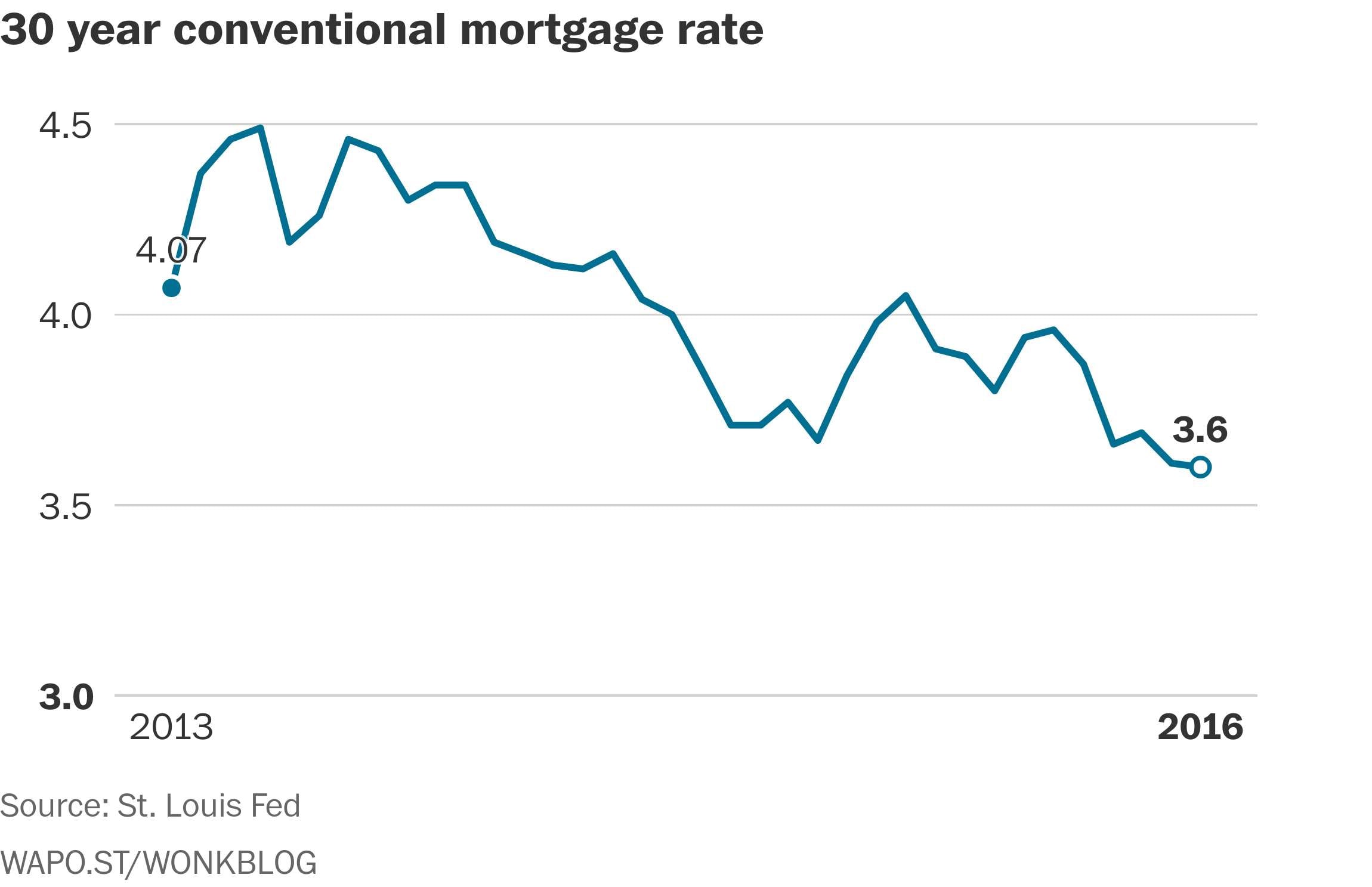
They’ve already hit rock bottom this year. In the past month alone, 30-year fixed-rate mortgages have hovered around 3.7 percent, nearly a three-year low. Britain’s vote to leave the European Union is expected to drive rates even lower.
GET CAUGHT UP
Summarized stories to quickly stay informed
Lawrence Yun, chief economist at the National Association of Realtors, said the low interest rates indicate low confidence in Americans’ ability to handle higher rates, due to a slew of factors both domestic and foreign. Rates have been about 17 percent lower than the median of this decade.
However, McBride said his long-term outlook does not change with the Brexit vote. He still estimates a rebound from ultra-low rates by year’s end.
By the end of 2016, Fratantoni expects rates to reach 4 percent. He noted that he’s turned his estimates more conservative in recent months, but predicts an increase nevertheless.
That could change with the Brexit referendum passing, however. He noted that Treasury rates had already dropped about 20 basis points by Friday morning.
“At this point, it is unclear whether this will just be a short term disruption, or whether it will have a longer-term impact,” Fratantoni said. “Our best guess at this point is that the impact on the mortgage market will be to keep mortgage rates lower for longer, likely leading to another pickup in refinance activity.”
International concerns, particularly slowing growth in China and Brexit, have played a major role in driving down mortgage rates. Until recently, Fratantoni said these global concerns typically did not affect domestic mortgage interest rates.
“Compared to 10, 20, 30 years ago, our rates are much more impacted by global circumstances than what used to be the case,” Fratantoni said. “We used to be much more of an island.”
International and domestic investors alike drive mortgage interest rates through the mortgage-backed security market. Because these securities are considered relatively stable, they attract buyers when economies and markets elsewhere flounder. Mortgage rates are also heavily influenced by the yield on 10-year Treasury notes, and investors have flocked to them to escape turbulence in foreign markets. Together, they have driven down mortgage rates for Americans.
Early Friday, as global markets shuddered, investors sought safety in gold, driving up the price.
Domestic worries have had a smaller, but notable, effect on keeping rates low. The U.S. economy is healthy, if not surging, with unemployment at its lowest since August 2007 and wage growth nearing pre-recession levels. But concerns still abound after a jobs report earlier this month showed a meager 38,000 jobs added in May. Interest rates fell about a tenth of a percent when it was released on June 3, according to a report released Tuesday by financial service investment firm Compass Point. The rate had climbed to 3.81 percent by June 1, but dropped to 3.74 percent the following week. It’s now at 3.73 percent.
These myriad concerns led Fed officials to vote this month to maintain its benchmark interest rate. They increased it by 0.25 percent in December, the first time since 2006. Federal Reserve Board Chair Janet L. Yellen said at the time that the Fed expected to raise rates at least four more times this year. Now, the central bank anticipates only two more increases, citing lack of inflation, the possibility of a British exit from the European Union and overall middling economic indicators.
Still, in testimony to the Senate Banking, Housing and Urban Affairs Committee on Tuesday, Yellen said she was “optimistic.” She said she believed hiring will pick up again in spite of sluggish growth in May and highlighted early signs of increasing wages. Earnings have risen 2.5 percent over the past year, helping to dispel concerns that growth had stalled at about 2 percent.
However, concerns of Brexit hindered a wholly optimistic outlook.
“We believe that will turn around, expect it to turn around,” Yellen said, “but we are taking a cautious approach … to make sure that expectation is borne out.”
Even with the looming fallout from Brexit and slow job growth, one expert at the National Association of Realtors pointed to price and wage upticks when he estimated higher mortgage interest rates. Yun said those increases may kick rates as high as 4.5 percent by this time next year.
Yun said rent is at a seven-year high and gas prices are inching upward. Those increases in prices — markers of inflation — often bump up borrowing rates across the board.
“For those who have been hesitant or busy with other aspects of their life, they should consider refinancing their mortgage to take advantage of the current low rates,” Yun said.
McBride echoed that. He anticipates modest growth to interest rates: “It makes a great time to refinance now regardless of the outlook down the road, simply because of how low rates have fallen.”
Many homeowners have already refinanced, Yun said. Refinancing comprises the majority of mortgage applications. That’s been the case for the past decade, McBride said, thanks to low interest rates and the breakneck speed of the housing market in the early 2000s.
The low rates this past quarter have been good for the housing market, though indicative of an overall mediocre economy. Mortgage applications increased 17 percent from the end of March through the beginning of June, according to the Compass Point report using the Mortgage Bankers Association market index. New purchase applications alone saw a boost of 27 percent during this time.
That means that more people are buying homes rather than simply refinancing their mortgage, which is indicative of economic growth.
Fratantoni said the boosts to the job market these past few years coupled with low mortgage rates is a “a very positive backdrop for housing and mortgage markets.”
“The housing sector it has always been sensitive to changes in mortgage rates,” Yun said. “If rates go up, sales go down.”
In any case, McBride recommended investigating refinancing if it’s possible to shave one-half to three-quarters of a percentage point off the interest rate while remaining on a fixed-rate loan. He added that, because many may also be refinancing their mortgage, to prepare all documents as quickly as possible to ensure your re-financing application is accepted quickly. Typical refinancing costs can range from several hundred to several thousand dollars.






